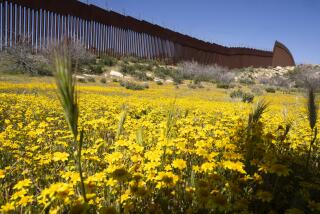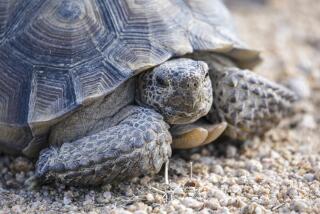Study Says More Species at Risk on LAX Dunes
- Share via
The tiny El Segundo Blue butterfly, the object of highly publicized rescue attempts since it was declared endangered in 1975, isn’t the only threatened species living on the sand dunes at Los Angeles International Airport.
That’s the conclusion of a 2 1/2-year study of the 302-acre El Segundo dunes at the west end of the airport’s runways. The study identified eight insects and a flower that apparently live only on the dunes and could also be classified as endangered, according to Rudi Mattoni, a geneticist who conducted the study for the city’s Department of Airports.
The insects include a cricket, spider, two beetles and four moths, he said. The flower is the spineflower, an annual.
“To our knowledge, they are nowhere else but the El Segundo dunes,” Mattoni said. “They are all riding on the same airplane, so to speak.”
The dunes have received much public attention in recent years because the area is a habitat for the butterfly, which is listed by the federal government as an endangered species. Habitats for the insect have successfully been established on the dunes at the airport and at the nearby Chevron oil refinery in El Segundo.
Mattoni said the study is probably the most exhaustive biological survey that has ever been done on the airport dunes. The dunes are the last large parcel of a dune system that once stretched from Point Conception south into Mexico.
Although most of the dunes are littered with the cracked concrete streets, fire hydrants and other remnants of a neighborhood condemned long ago to establish a clear zone for overflying aircraft, 43 acres have been left largely untouched.
Of the animal and plant species that exist on the airport dunes, the study identified 28 that are indigenous to the original dune system. There probably is a larger number of such species, but that estimate is the best available, given present scientific knowledge of the dune system, the study states.
Over the years, native plant and animal life on the dunes have been seriously affected by development and soil contamination, which in turn have allowed non-native species to invade the area, according to the study. Of the 20 original mammals believed to have occupied the dunes, only three--gophers, pack rats and meadow mice--remain, Mattoni said.
Of 91 plant species that once existed on the airport dunes, only 58 are now found there and 19 are in danger of being eliminated, he said.
Mattoni embarked on his study in May, 1987, months after the California Coastal Commission refused to give the airport permission to build a golf course and a 100-acre nature preserve on the dunes. The commission said it was unclear what effect the golf course would have on the butterfly.
Even though the Los Angeles City Council years ago unanimously approved the plan for the golf course and preserve, the coastal commission recently informed city planners that, under state law, another public hearing must be held because more than four years have elapsed since it was submitted to the commission. Also, the City Council must vote again on the matter, the commission said.
At the same time, Councilwoman Ruth Galanter is seeking to have the entire project reviewed by city planners. The councilwoman favors the construction of a golf course on a portion of the dunes but wants the preserve area significantly enlarged, perhaps to 200 acres, according to her spokesman.
Maurice Laham, the airport’s chief environmental officer, said the butterfly, as well as the other eight rare insects and the flower identified by the study, were all found within the acreage that the airport has earmarked for the nature conservancy.
By comparison, in his judgment, the area where the proposed golf course would be built is as barren as the moon, he said.
For more than four years, airport officials have worked to establish a habitat for the butterfly. Under Mattoni’s direction, non-native plants that were crowding out vegetation eaten by the butterfly were removed. Since work began, the size of the butterfly population has increased from about 400 to at least 2,000, according to Mattoni.
The butterfly habitat is located within a 46-acre parcel that the airport has been attempting to restore. Plants not indigenous to the dunes have been removed and native vegetation has been planted. A nursery has been set up to propagate rare plants, Mattoni said.
In addition, 32 red foxes have been trapped and removed from the area during the last 18 months. The non-native animals have wreaked havoc with the dunes ecosystem by eating native animals, reptiles and birds, Mattoni said. An unknown number of foxes remain.
The study concludes that it could cost $35,000 an acre to restore the entire dune area. That would include the cost of removing 30,000 cubic yards of concrete and rubble and 10,000 cubic yards of non-native plants, as well as restocking the area with native plants.
By comparison, restoring the 100-acre preserve would cost an average of $9,000 an acre, according to the study. A major reason for the lower cost is because the preserve would include the 43 acres that have been left largely undisturbed. Mattoni’s study will be formally presented to airport officials April 24.
More to Read
Sign up for Essential California
The most important California stories and recommendations in your inbox every morning.
You may occasionally receive promotional content from the Los Angeles Times.













